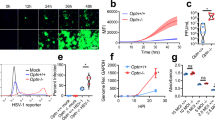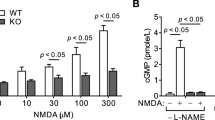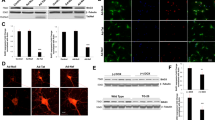Abstract
Studies utilizing gene delivery to the nervous system indicate that various strategies are protective following acute neurological insults such as seizure and stroke. We have found that inhibitors of apoptosis are protective against excitotoxicity and heat stress but not energetic impairment in vitro. Here we studied the neuroprotective efficacy in vivo of these mediators: viral genes (crmA, p35, γ34.5 KsBcl-2) that have evolved to suppress suicidal host responses to infection, by inhibiting apoptosis. We investigated these effects by utilizing modified herpes vectors to deliver the anti-apoptotic agents intracerebrally and examined them in the face of excitotoxic and metabolic insults. We found that p35 and γ34.5 reduced by 45% a hippocampal CA3 lesion caused by kainic acid, while crmA and KsBcl-2 did not. None of the inhibitors protected the dentate gyrus of the hippocampus following 3-acetylpyridine, a hypoglycemia model, but we found crmA to worsen the damage. These data are similar to our results in neuronal cultures where the inhibitors protected against the excitotoxin domoic acid, but not against the metabolic poison, cyanide. Together, the results suggest that inhibitors of various apoptotic elements are capable of protecting under acute insult conditions both in vitro and in vivo, suggesting possible future therapeutic applications.
This is a preview of subscription content, access via your institution
Access options
Subscribe to this journal
Receive 12 print issues and online access
$259.00 per year
only $21.58 per issue
Buy this article
- Purchase on Springer Link
- Instant access to full article PDF
Prices may be subject to local taxes which are calculated during checkout




Similar content being viewed by others
References
Martin L.J. et al. Neurodegeneration in excitotoxicity, global cerebral ischemia, and target deprivation: a perspective on the contributions of apoptosis and necrosis Brain Res Bull 1998 46: 281 281
Wullner U. et al. Evidence for an active type of cell death with ultrastructural features distinct from apoptosis: the effects of 3-acetylpyridine neurotoxicity Neuroscience 1997 81: 721 721
Fujikawa D.G., Shinmei S.S., Cai B. . Kainic acid-induced seizures produce necrotic, not apoptotic, neurons with internucleosomal DNA cleavage: implications for programmed cell death mechanisms Neuroscience 2000 98: 41 41
Xu D.G. et al. Elevation of neuronal expression of NAIP reduces ischemic damage in the rat hippocampus Nat Med 1997 3: 997 997
Xu D.G. et al. Elevation of neuronal expression of NAIP reduces ischemic damage in the rat hippocampus
Betz AL, Schielke GP, Yang GY. Interleukin-1 in cerebral ischemia. Keio J Med 1996; 45: 230–237; discussion 238 Proc Natl Acad Sci USA 1995 92: 7247 7247
Phillips R.G. et al. Calbindin D28K gene transfer via herpes simplex virus amplicon vector decreases hippocampal damage in vivo following neurotoxic insults J Neurochem 1999 73: 1200 1200
Phillips R.G., Lawrence M.S., Ho D.Y., Sapolsky R.M. . Limitations in the neuroprotective potential of gene therapy with Bcl-2 Brain Res 2000 859: 202 202
Sapolsky R.M., Steinberg G.K. . Gene therapy using viral vectors for acute neurologic insults Neurology 1999 53: 1922 1922
Lawrence M.S. et al. Overexpression of Bcl-2 with herpes simplex virus vectors protects CNS neurons against neurological insults in vitro and in vivo J Neurosci 1996 16: 486 486
Lawrence M.S. et al. Overexpression of Bcl-2 with herpes simplex virus vectors protects CNS neurons against neurological insults in vitro and in vivo
Linnik MD, Zahos P, Geschwind MD, Federoff HJ. Expression of bcl-2 from a defective herpes simplex virus-1 vector limits neuronal death in focal cerebral ischemia. Stroke 1995; 26: 1670–1674; discussion 1675 Exp Neurol 1999 156: 130 130
Myers K.M. et al. Bcl-2 protects neural cells from cyanide/aglycemia-induced lipid oxidation mitochondrial injury and loss of viability J Neurochem 1995 65: 2432 2432
Zhou Q. et al. Interaction of the baculovirus anti-apoptotic protein p35 with caspases. Specificity, kinetics, and characterization of the caspase/p35 complex Biochemistry 1998 37: 10757 10757
Bump N.J. et al. Inhibition of ICE family proteases by baculovirus antiapoptotic protein p35 Science 1995 269: 1885 1885
Chou J., Roizman B. . The gamma 1(34.5) gene of herpes simplex virus 1 precludes neuroblastoma cells from triggering total shutoff of protein synthesis characteristic of programed cell death in neuronal cells Proc Natl Acad Sci USA 1992 89: 3266 3266
Palumbo G.J. et al. Inhibition of an inflammatory response is mediated by a 38-kDa protein of cowpox virus Virology 1989 172: 262 262
Pickup D.J. et al. Hemorrhage in lesions caused by cowpox virus is induced by a viral protein that is related to plasma protein inhibitors of serine proteases Proc Natl Acad Sci USA 1986 83: 7698 7698
Cheng E.H. et al. A Bcl-2 homolog encoded by Kaposi sarcoma-associated virus, human herpesvirus 8, inhibits apoptosis but does not heterodimerize with Bax or Bak Proc Natl Acad Sci USA 1997 94: 690 690
Roy M., Hom J., Sapolsky R.M. . Neuroprotection with herpes simplex vectors expressing virally derived anti-apoptotic agents Brain Res 2001 901: 12 12
Fink S.L., Chang L.K., Ho D.Y., Sapolsky R.M. . Defective herpes simplex virus vectors expressing the rat brain stress-inducible heat shock protein 72 protect cultured neurons from severe heat shock J Neurochem 1997 68: 961 961
Dash R., Lawrence M., Ho D., Sapolsky R. . A herpes simplex virus vector overexpressing the glucose transporter gene protects the rat dentate gyrus from an antimetabolite toxin Exp Neurol 1996 137: 43 43
Sperk G. . Kainic acid seizures in the rat Prog Neurobiol 1994 42: 1 1
Hicks S. . Pathologic effects of antimetabolites Am J Pathol 1955 31: 189 189
Desclin J., Escubi J. . Effects of 3-acetylpyridine on the central nervous system of the rat, as demonstrated by silver methods Brain Res 1974 77: 349 349
Coggeshall R., MacLean P. . Hippocampal lesions following administration of 3-acetylpyridine Proc Soc Exp Biol Med 1958 98: 687 687
Yenari M.A. et al. Gene therapy with HSP72 is neuroprotective in rat models of stroke and epilepsy Ann Neurol 1998 44: 584 584
Pollard H. et al. Kainate-induced apoptotic cell death in hippocampal neurons Neuroscience 1994 63: 7 7
Pollard H. et al. Apoptosis associated DNA fragmentation in epileptic brain damage Neuroreport 1994 5: 1053 1053
Viswanath V. et al. Transgenic mice neuronally expressing baculoviral p35 are resistant to diverse types of induced apoptosis, including seizure-associated neurodegeneration Proc Natl Acad Sci USA 2000 97: 2270 2270
Venero J.L., Revuelta M., Machado A., Cano J. . Delayed apoptotic pyramidal cell death in CA4 and CA1 hippocampal subfields after a single intraseptal injection of kainate Neuroscience 1999 94: 1071 1071
Filipkowski R.K., Hetman M., Kaminska B., Kaczmarek L. . DNA fragmentation in rat brain after intraperitoneal administration of kainate Neuroreport 1994 5: 1538 1538
Nath R., Probert A. Jr, McGinnis K.M., Wang K.K. . Evidence for activation of caspase-3-like protease in excitotoxin- and hypoxia/hypoglycemia-injured neurons J Neurochem 1998 71: 186 186
Roy M., Sapolsky R. . Neuronal apoptosis in acute necrotic insults: why is this subject such a mess? Trends Neurosci 1999 22: 419 419
Portera-Cailliau C., Price D.L., Martin L.J. . Non-NMDA and NMDA receptor-mediated excitotoxic neuronal deaths in adult brain are morphologically distinct: further evidence for an apoptosis-necrosis continuum J Comp Neurol 1997 378: 88 88
Ferrer I. et al. Both apoptosis and necrosis occur following intrastriatal administration of excitotoxins Acta Neuropathol 1995 90: 504 504
Ekert P.G., Silke J., Vaux D.L. . Caspase inhibitors Cell Death Differ 1999 6: 1081 1081
Kondratyev A., Gale K. . Intracerebral injection of caspase-3 inhibitor prevents neuronal apoptosis after kainic acid-evoked status epilepticus Brain Res Mol Brain Res 2000 75: 216 216
Bachis A. et al. Interleukin-10 prevents glutamate-mediated cerebellar granule cell death by blocking caspase-3-like activity J Neurosci 2001 21: 3104 3104
Srivastava R.K., Mi Q.S., Hardwick J.M., Longo D.L. . Deletion of the loop region of Bcl-2 completely blocks paclitaxel-induced apoptosis Proc Natl Acad Sci USA 1999 96: 3775 3775
Alirezaei M. et al. Inhibition of protein synthesis in cortical neurons during exposure to hydrogen peroxide J Neurochem 2001 76: 1080 1080
Marin P. et al. Glutamate-dependent phosphorylation of elongation factor-2 and inhibition of protein synthesis in neurons J Neurosci 1997 17: 3445 3445
Munoz F. et al. Ischemia-induced phosphorylation of initiation factor 2 in differentiated PC12 cells: role for initiation factor 2 phosphatase J Neurochem 2000 75: 2335 2335
Scorsone K.A., Panniers R., Rowlands A.G., Henshaw E.C. . Phosphorylation of eukaryotic initiation factor 2 during physiological stresses which affect protein synthesis J Biol Chem 1987 262: 14538 14538
Alcazar A., Bazan E., Rivera J., Salinas M. . Phosphorylation of initiation factor 2 alpha subunit and apoptosis in Ca2+ ionophore-treated cultured neuronal cells Neurosci Lett 1995 201: 215 215
Ho D.Y. . Amplicon-based herpes simplex virus vectors Meth Cell Biol 1994 43: 191 191
Hashizume K., Tanaka T. . Multiple subpial transection in kainic acid-induced focal cortical seizure Epilepsy Res 1998 32: 389 389
Henshall D.C., Sinclair J., Simon R.P. . Spatio-temporal profile of DNA fragmentation and its relationship to patterns of epileptiform activity following focally evoked limbic seizures Brain Res 2000 858: 290 290
Acknowledgements
The authors wish to thank Dr Ted Dumas for his advice on the project. This work was supported by NIH RO1 NS32848 and the TDRDP of the State of California to RMS and an Undergraduate Research Opportunity Howard Hughes’ Grant to JJH.
Author information
Authors and Affiliations
Rights and permissions
About this article
Cite this article
Roy, M., Hom, J. & Sapolsky, R. HSV-mediated delivery of virally derived anti-apoptotic genes protects the rat hippocampus from damage following excitotoxicity, but not metabolic disruption. Gene Ther 9, 214–219 (2002). https://doi.org/10.1038/sj.gt.3301642
Received:
Accepted:
Published:
Issue Date:
DOI: https://doi.org/10.1038/sj.gt.3301642
Keywords
This article is cited by
-
Cell-specific gene therapy driven by an optimized hypoxia-regulated vector reduces choroidal neovascularization
Journal of Molecular Medicine (2018)
-
SK2 potassium channel overexpression in basolateral amygdala reduces anxiety, stress-induced corticosterone secretion and dendritic arborization
Molecular Psychiatry (2009)
-
Epilepsy and Apoptosis Pathways
Journal of Cerebral Blood Flow & Metabolism (2005)
-
Neuroprotective gene therapy against acute neurological insults
Nature Reviews Neuroscience (2003)



